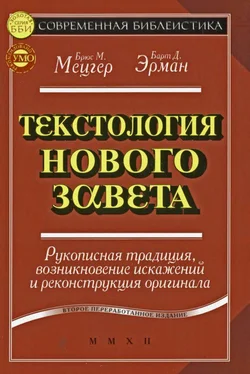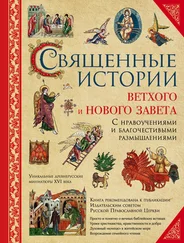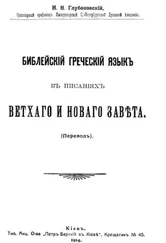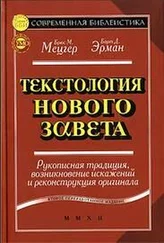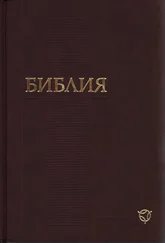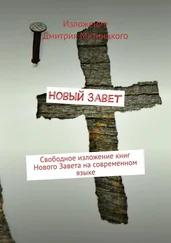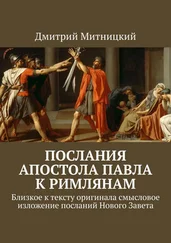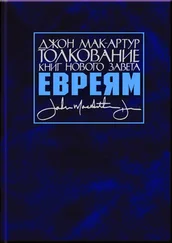Согласно Эдварду Розену (Rosen), очки были изобретены в Италии в первой половине XIV века, см. его статью «The Invention of Eyeglasses», Journal of History of Medicine and Allied Sciences, vol. 11 (1956), pp. 13–46 and 183–218.
Alfred Wikenhauser, Einleitungin das Neue Testament (Freiburg, 1953), pp. 49–50; Англ. пер.: New Testament Inroduction (New York, 1958), p. 67; также A. Wikenhauser, Josef Schmid, Einleitung in das Neue Testament , sechste, völlig bearbeitete Aufl. (Freiburg im Breisgau, 1973), p. 69.
См. F. Nau in Revue de l'Orient chrétien , xvi (1911), pp. 428–429.
Перечень ошибок переписчика, составленный Генри Сандерсом (Sanders) и Карлом Шмидтом (Schmidt) см.: The Minor Prophets in the Freer Collection and the Berlin Fragment of Genesis (New York, 1927), pp. 244–246. Примеры вариантных чтений в Кодексе Безы, которые могли возникнуть еще в предшествующем курсивном тексте, см. списки Пауля Глауэ (Glaue) в Zeitschrift für neutestamentliche Wissenschaft, xlv (1954), p. 92–94. Возможно, что p 75имел курсивного предшественника, в котором имя богатого человека в Лк 16:19 было написано как (ὀνόματι) Νευης, что, возможно является гаплографией (ὀνόματι) Νινευης. Сходство между слогом τι и буквой ν в маюскульном написании отсутствует, но в некоторых формах курсивного письма I века н. э. написание τι было очень прочесть как ν; примеры см. E. M. Thompson, Handbook of Greek and Latin Palaeography (New York, 1893), фототаблица после с. 148; L. Gonanza da Fonesca, Epitome introductionis in palaeographiam graecam (biblicam), ed altera (Rome, 1944), pp. 85, 94 f.
О возможности перемещения взгляда переписчика на другую колонку текста оригинала говорят примеры, приведенные Джеймсом Ренделом Харрисом (Harris) в American Journal of Philology, vi (1885), pp. 25–40.
Начиная со II в. до н. э. буквы греческого алфавита использовались для обозначения чисел. В дополнение к 24 буквам алфавита применялись и вышедшие из употребления знаки: дигамма (ϝ) или стигма (ς) для обозначения числа 6, коппа (ϙ или ҁ) для обозначения 90, и сампи (ϡ) для обозначения 900. Первые девять букв алфавита обозначали единицы, вторые девять — десятки, третьи девять букв — сотни; а́ = 1, β́ = 2, γ́ = 3, δ́ =4, έ =5, ϝ́ или ς́ = 6, ζ́ =7, ή = 8, θ́ = 9, ί =10 (ιά = 11, ιβ́ =12 и т. д), κ́ = 20, λ́ =30, μ́ = 40, ν́ = 50, ξ́ 60, ό =70, π́ = 80, ϙ́ или ҁ́ = 90, ρ́ = 100, σ́ = 200, τ́ = 300, ύ = 400, φ́ = 500, χ́ = 600, ψ́ = 700, ώ = 800, ϡ́ = 900, ̗α = 1000, ̗β = 2000, ̗γ = 3000, и т. д.
* Так же в церковнославянском печатном тексте и в русском Синодальном переводе.
Другие примеры со ссылками на соответствующие рукописи Нового Завета см. Blass, Debrunner, Funk. A Greek Grammar of the New Testament and Other Early Christian Literature (Chicago, 1961), § 14.
Другие примеры влияния лекционариев можно найти в монографии: B. M. Metzger, The Saturday and Sunday Lessons from Luke in the Greek Gospel Lectionary (Chicago, 1944), pp. 14–17.
Список из более 600 подобных примеров см. Reuben J. Swanson, «Unique and even Bizarre Readings in Manuscripts of 1 Corinthians», New Testament Greek Manuscripts… 1 Comthians (Wheaton, IL, 2003), pp. 459–487. Суонсон также предлагает перечень «Passages Marked with Umlaut [̈] in Vaticanus», pp. 293–304. См. также J. Edgar Miller, «Some Observationson the Text-Critical Function of the Umlauts in Vaticanus, with Special Attention to Corinthians 14:34–35», Journal for the Study of the New Testament , xxvi (2003). Миллер делает из своих заключений вывод, что: Переписчик ватиканского кодекса последовательно ставит «умлауты» против строки, содержащей неясное чтение, а не против предшествующей. Это исключает 1 Кор 14:34–35 как вариант, на который указывает умлаут на полях, так как он отмечает строчку, содержащую последние слова 1 Кор 14:33, а не следующую, начинающуюся с 1 Кор 14:34.
Описание других рукописей, в которых в генеалогии Иисуса в Евангелии от Луки Иисуса допущены большие или меньшие ошибки, см. Jacob Geerlings, Family П in Luke (Studies and Documents, xxii (Salt Lake City, 1962), pp. 127–137.
По данному вопросу см. Eric L. Titus, «The Motivations of Changes made in the New Testament Text by Justin Martyr and Clement of Alexandria: a Study in the Origin of New Testament Variation» (Diss., University of Chicago, 1942); C. S. C. Williams, Alterations to the Text of Synoptic Gospels and Acts (Oxford, 1951); Leon E. Wright, Alterations of the Words of Jesus as Quoted in the Literature of the Second Century (Cambridge, MA, 1952); E. W. Saunders, «Studies in Doctrinal Influence on the Byzantine Text of the Gospels», Journal of Biblical Literature, lxxi (1952), pp. 85–92; K. W. Clark, «Textual Criticism and Doctrine», Studia Paulina in honorem Joahnnis de Zwaan (Haarlem, 1953), pp. 52–65; Eric Fascher, Textgeschichte als hermeneutisches Problem (Halle/S., 1953); Manfred Kametzki, «Textgeschichte als Überlieferungsgeschichte» Zeitschrift für die neutestamentlische Wissenschaft, xlvii, 1956, pp. 170–180; Eldon Jay Epp, The Theological Tendency of Codex Bezae Cantabrigiensis in Acts (Cambridge, 1966); Alexander Globe, «Some Doctrinal Variants in Matthew 1 and Luke 2 and the Authority of the Neutral Text», Catholic Biblical Quarterly, xlii (1980), pp. 52–72; Peter M. Head, «Christology and Textual Transmission: Reverential Alterations in the Synoptic Gospels», Novum Testamentum, xxxv (1993), pp. 105–129; Bart D. Ehrman, The Orthodox Corruption of Scripture: The Effect of Early Christological Controversies on the Text of the New Testament (Oxford, 1993); idem, «The Text as Window: New Testament Manuscripts and the Social History of Early Christianity», в The Text of the New Testament in Contemporary Research, ed. by Ehrman and Holmes, pp. 361–379.
Читать дальше
